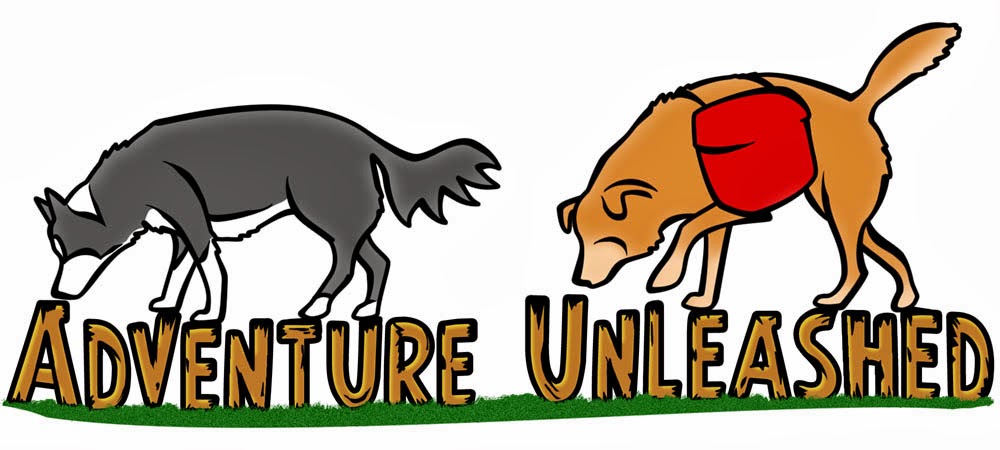With it being winter you probably think I am going to write about how you should teach your dog to walk nicely on a leash so that you don’t slip and fall down. Well, you should know a secret about Adventure Unleashed’s dogs. We don’t CARE about teaching our dogs to walk nicely on a leash. We can (and our old, responsible dogs have accidentally learned not to pull unless they are on a harness) but think there are more important things to learn first. Like how to jump and balance on a tiny post or walk across a tiny tree over a river.
So what might I be writing about with that title?
It’s something we have been contemplating, discussing, recontemplating and then rediscussing for a few months over here at Adventure Unleashed.
Let’s start with a story.
When we first started teaching indoor class, we would find an AWESOME new toy at the store, buy it, and our dogs would play on it (ahem, I mean TEST it). Then, we would excitedly introduce the toy in class, only to have people mildly disappointed that their dogs were slipping on the toy. So we started putting grippy things on EVERYTHING. It became our thing. We were experts at cutting the grippy stuff into JUST the right shape and convincing the duct tape to bend to our will around crazy corners.

And we were happy with how much more confident our beginner dogs were to try the objects once it was a grippy surface. But something was missing. We started thinking back to when we first brought the toys home and our dogs would happily play on them with no trouble. What was different about OUR dogs than the dogs at class? Why would they play on these toys when even our more advanced dogs had trouble?
After a decent amount of discussion we figured out that it was because our dogs had learned how to avoid slipping as much as possible and how to recover when they do begin to slip. Suddenly, we had yet another unusual skill that we accidentally taught our dogs and now needed to teach the dogs in class.
Learning to be steady on slippery surfaces seems to be a combination of several skills. First, it requires a good deal of core strength. The dogs need to be able to hold each of their limbs close to their body without bracing them against a sticky surface. You’ve probably seen (and chuckled at) the dog who sits on a tile floor and his front feet start to slide out until he is in a down. A dog with enough core strength to hold his front legs in the proper position won’t have this problem.
 Second, the dog needs to be comfortable with falling and being spotted. The fastest way to have a problem slipping is for the dog to begin to get worried about their footing. When this happens, most dog’s first reactions are to dig in with their claws and begin to move in more frantic ways. We noticed when watching our dogs that when they began to slip, they moved in very predictable ways, shifting their weight to more stable feet, in an attempt to correct this. We never saw them attempt to dig in with their nails and if they couldn’t stop the slipping, they simply got off in a controlled manner (what we like to refer to as a controlled bail). By knowing how to shift weight, and how to bail safely, our dogs are able to safely handle the demands of a slippery surface.
Second, the dog needs to be comfortable with falling and being spotted. The fastest way to have a problem slipping is for the dog to begin to get worried about their footing. When this happens, most dog’s first reactions are to dig in with their claws and begin to move in more frantic ways. We noticed when watching our dogs that when they began to slip, they moved in very predictable ways, shifting their weight to more stable feet, in an attempt to correct this. We never saw them attempt to dig in with their nails and if they couldn’t stop the slipping, they simply got off in a controlled manner (what we like to refer to as a controlled bail). By knowing how to shift weight, and how to bail safely, our dogs are able to safely handle the demands of a slippery surface.
We have now started systematically adding slippery surfaces into our classes as dogs become more advanced. We start with textured but slightly slippery surfaces on a low, wide object and progress to higher, smaller, and more slippery surfaces.
Being able to adapt quickly to changing surfaces makes our parkour dogs more resistant to injury and better able to maintain mobility as they age. Since the dogs know where their body is in space, how it moves, how to adapt to sliding, and how to “bail” safely, they become better athletes who are able to maintain a high quality of movement for as long as possible.
So what are your waiting for? Start giving your dog the benefits of “slide training” today!

